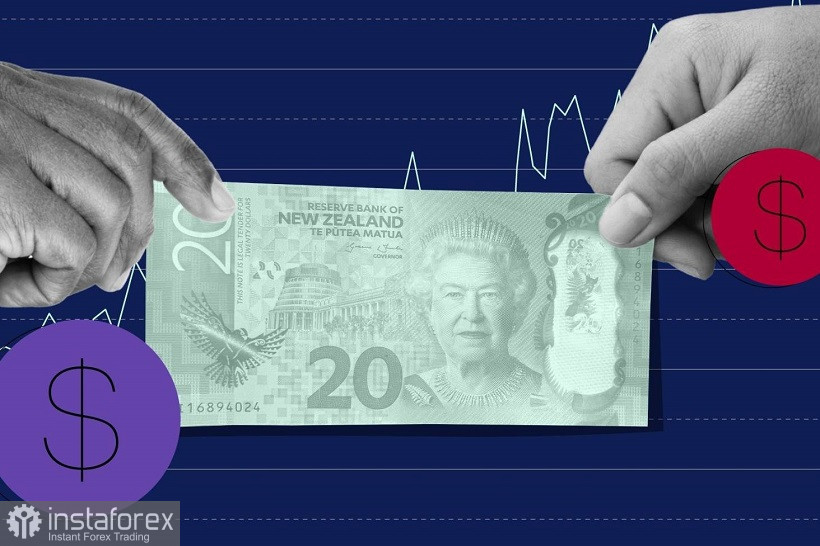The New Zealand dollar paired with the greenback tried to go on the attack on Wednesday, reacting to the results of the Reserve Bank of New Zealand's October meeting. However, in the second half of the day the kiwi lost all the won points and renewed the daily low. Another corrective momentum faded away, and NZD/USD bears went into short positions at a better price, thus indicating the priority of shorts.

In general, the pair has been within the downward trend since mid-August. Take a look at the weekly chart: at the end of summer, the kiwi reached a local price high at 0.6450. But after that, the kiwi began to plunge amid the general strengthening of the US currency. Despite the short-term corrective pauses, the downward dynamics was of a main character. All this led to the fact that the pair last week updated a two-year low, reaching a target of 0.5560. In other words, the pair has completed a 900-point downward marathon in just a few months, almost without encountering any distinct resistance from bulls. Therefore, the current price growth can be considered exclusively as a corrective one. The upward pullback of the NZD/USD is due to the temporary weakening of the greenback throughout the market and the reaction of traders to the results of the RBNZ's meeting. However, these fundamental factors will not be able to support the bulls for a long time.
So, during Wednesday's Asian trading session, the Reserve Bank of New Zealand announced an increase in the discount rate by 50 basis points, to 3.5%. Despite the fact that this scenario was the baseline for the October meeting of the RBNZ, the NZD/USD pair still showed a positive reaction: the price jumped to 0.5800, updating the two-week high. But bulls could not gain a foothold within the 58th figure, and in general could not hold their positions: after a few hours, the pair turned 180 degrees and collapsed almost 150 points down.
And it's not just the behavior of the US currency (the dollar index began to gain momentum in the afternoon) – it's the weakening of the New Zealand dollar itself. For example, the AUD/NZD cross-pair also reflected the weakening of the kiwi after a sharp gain immediately after the announcement of the results of the October meeting.
On the one hand, the RBNZ increased the interest rate by 50 points, thereby supporting the national currency. On the other hand, the New Zealand central bank has made it clear that it will maintain a moderate pace of tightening monetary policy. Commenting on the results of the October meeting, RBNZ Governor Adrian Orr said that the committee considered the possibility of raising the rate by 50 or 75 basis points – "but decided to stop at the 50-point option, which is suitable for maintaining price stability and contributes to maximum sustainable employment." At the same time, he noted that New Zealand's production capacity is constrained by a shortage of labor resources, and the pressure on wages is "only increasing."
In general, the RBNZ maintained a hawkish course, intending to curb inflationary growth after all. But after the release of the latest data on the growth of the New Zealand economy, there were active suggestions in the market that the central bank could take more drastic measures, meaning a 75-point rate hike. Let me remind you that New Zealand's GDP in the second quarter increased by 1.7% on a quarterly basis, while most analysts expected a more modest increase of 1.0%. At the same time, negative dynamics was recorded in the first quarter: the economy of the island state decreased by 0.2% (QoQ). On an annualized basis, the indicator increased by 0.4%, against the expected increase of 0.2%.
Thus, the RBNZ provided only situational support to the New Zealand dollar on Wednesday: the central bank did not resort to aggressive rate hikes, although it maintained a hawkish rate. In such conditions, the kiwi remains the wingman, and the greenback continues to play the role of the first violin.
It should be noted here that the US dollar index partially recovered its positions on Wednesday. After the disastrous report on the growth of the ISM index in the manufacturing sector (which was published on Monday), the September index of business activity in the services sector from ISM was published on Wednesday. It surpassed the pessimistic forecasts of experts, ending up at 56.7 (that is, the indicator actually remained at the August level with the forecast of a decline to 55.5). Against this background, dollar bulls again reminded themselves after a short corrective pause.
If we talk about the technical side of the issue, then the priority is definitely for the downside. Firstly, on the four-hour chart, the Ichimoku indicator has formed a bearish Parade of Lines signal, in which the price is under all its main lines and under the Kumo cloud. Secondly, the pair is located between the middle and lower lines of the Bollinger Bands indicator, which also indicates a downward trend. The nearest bearish target (support level) is 0.5600, which corresponds to the lower line of the Bollinger Bands indicator on H4.
 English
English 
 Русский
Русский Bahasa Indonesia
Bahasa Indonesia Bahasa Malay
Bahasa Malay ไทย
ไทย Español
Español Deutsch
Deutsch Български
Български Français
Français Tiếng Việt
Tiếng Việt 中文
中文 বাংলা
বাংলা हिन्दी
हिन्दी Čeština
Čeština Українська
Українська Română
Română

